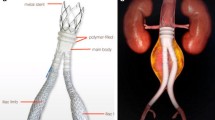Abstract
Purpose: To report our experience with stent-graft treatment of acute aortic injuries. Materials and methods: Emergent stent-graft placement was considered in patients with acute aortic rupture or injury who were deemed to be high-risk candidates for surgery. After medical stabilization, patients were evaluated for suitability for endovascular interventions. Anatomic criteria for stent-grafting included: (1) contained ruptures of the thoracic aorta located distal to the left subclavian artery and above the celiac axis, and (2) a proximal and distal neck of ≥ 15 mm in length and ≤ 40 mm in diameter. Stent-grafts consisted of a modified Z-stent endoskeleton covered with woven polyester vascular graft material. All devices were placed under general endotracheal anesthesia. A transfemoral approach was utilized if the iliofemoral artery diameter was ≥ 8 mm. For iliofemoral diameters < 8 mm, the catheters were inserted directly into the infrarenal aorta after a retroperitoneal exposure. Patient follow-up consisted of angiography and spiral CT scan prior to discharge from the hospital. Subsequent spiral CT studies were performed at 6 and 12 months, and at 1-year intervals thereafter. Results: Thirteen patients (11 men and 2 women) with a mean age of 60 years (range 34–81 years) underwent emergent placement of thoracic stent-grafts for acute aneurysmal rupture (n = 8), traumatic transection (n = 3), or tumor and abscess erosions (n = 2). The stent-grafts were deployed successfully in all cases and there were no cases of embolization, paraplegia, or stent-graft migration. No patient required surgical conversion. The average stent-graft dimension was 34 mm in diameter (range 24–38 mm) by 15.8 cm in length (range 5.0–17.5 cm). No patient with traumatic aortic injury was excluded on the basis of anatomic criteria. Two patients died within 1 month of the procedure, one of ventricular rupture and the other of cardiac arrest on day 28 after an uneventful hospital course for a ruptured aneurysm. Conclusion: The preliminary experience from our series demonstrates that aortic stent-grafting for traumatic aortic injury is technically feasible and can be used to treat thoracic aortic rupture in patients at high risk for standard operative therapy.
Similar content being viewed by others
Author information
Authors and Affiliations
Rights and permissions
About this article
Cite this article
Shen, C., Razavi, M., Semba, C. et al. Use of endoluminal stent-grafts in acute aortic rupture. Emergency Radiology 6, 197–203 (1999). https://doi.org/10.1007/s101400050052
Issue Date:
DOI: https://doi.org/10.1007/s101400050052




